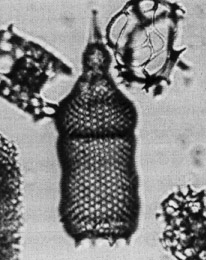 Theocorythium
trachelium trachelium (Ehrenberg)
Theocorythium
trachelium trachelium (Ehrenberg) Theocorythium
trachelium trachelium (Ehrenberg)
Theocorythium
trachelium trachelium (Ehrenberg)Eucyrtidium trachelius Ehrenberg, 1872a, p.312
Theocorythium trachelium trachelium (Ehrenberg), Nigrini, 1967, p.79, pl.8, fig.2, pl.9, fig.2
Shell rather rough and thick-walled. Cephalis in 2 parts: (1) spherical portion, with circular to subcircular pores, bearing a 3-bladed apical horn, 1 or 2 times its length; and (2) "neck", separated from the first part by an internal ringlike ledge, pores similar but larger and in 2 transverse rows, shell a little heavier. This "neck" is apparently homologous with the paired lobes of a trilocular cephalis in which the lobes are directly beneath the larger unpaired lobe. Collar structure at the base of the "neck". Apical spine incorporated in the cephalic wall (both spherical and "neck" parts). Primary lateral and dorsal spines continue as ribs in the thoracic wall for about half its length; sometimes these project, or are external, forming small wings.
Thorax large, distinctly cupola-shaped (conical above, expanded below) with hexagonally framed, circular to subcircular pores, closely spaced, quincuncially arranged and aligned longitudinally, 12-15 on a half-equator, 8-10 in a vertical series. Pronounced lumbar stricture.
Abdomen usually elongate, cylindrical or with a slight medial constriction. Pores similar in size, shape, and arrangement to those of the thorax, 12-15 on a half-equator, 8-14 in a vertical series.
Slight terminal constriction usually with 4-6 triangular lamellar teeth. Some specimens have similar subterminal teeth near the mouth or scattered irregularly over the distal half of the abdomen. In most specimens a peristome is either absent or only poorly developed, but a few have a well-differentiated poreless peristome (Nigrini, 1967).
Based on 20 specimens. Total length (excluding apical horn and terminal teeth) 146-209 µm. Length of cephalis 27-36 µm; of thorax 45-72 µm; of abdomen (excluding terminal teeth) 54-109 µm. Maximum breadth of cephalis 27-36 µm; of thorax 81-100 µm; of abdomen 72-100 µm (Nigrini, 1967).
Lower part of the cephalis forms a "neck" to the inflated conical or cupola-shaped thorax. Abdomen subcylindrical or slightly expanding distally, with small triangular teeth terminally and sometimes also on distal part of abdomen. A poorly developed poreless peristome is associated with the slight terminal constriction (Riedel and Sanfilippo, 1978a).
T. t. trachelium is distinguished from T. vetulum and from T. trachelium dianae (Nigrini, 1967, p.77, pl.8, figs.1a-1b, pl.9, figs.1a-1b) by its cylindrical abdomen. T. t. dianae is restricted to middle latitudes (higher than 30°).
The character that varies the most is the length of the abdomen. Rare specimens have an abdomen shorter than the thorax, and in some it may be as much as three times the length of the thorax. Also, the terminal teeth range from quite large to barely noticeable or even absent (Sanfilippo et al., 1985).
There is a undescribed form similar to T. trachelium, but with a much shorter abdomen, with a range well before the first appearance of T. trachelium.
Common in low-latitude Quaternary sediments from the Pacific and Indian Oceans. Absent in samples south of 35°S in the Indian Ocean, but present as far north as 40-45°N in the Pacific Ocean. Its morphotypic first appearance lies within the Pterocanium prismatium Zone, but is a diachronous event by approximately 1 m.y. (older in the tropical Indian Ocean than in the tropical Pacific Ocean). It is extant.
It has been assumed in some of the literature (Riedel and Sanfilippo, 1978a; Baker, 1983; Johnson et al., 1989) that T. vetulum evolved into T. trachelium. We think now that there may be a more complex relationship between T. trachelium, T. vetulum and an undescribed form, similar to T. trachelium, but with a much shorter abdomen (Caulet et al., 1993).